Katie Cook on Making Wine in the Midwest
Homepage photo: John Thull and Katie Cook of the University of Minnesota.
Visiting the University of Minnesota Research Center, I was surprised to see vinifera growing in the vineyard. What are all those old world vines doing in the mecca of cold climate hybrids?
The vinifera is primarily for breeding, to bring vinifera traits into our hybrids. Vinifera also forms a standard. We know enough about vinifera to have formed a baseline for what it’s supposed to taste like.
Certainly you’re not trying to get vinifera to grow commercially in Minnesota?
Vinifera is not commercially viable here. Riesling is the only one that will ripen. We got 20 brix from Riesling this year.
You’re doing a presentation on sweet wine at the 2013 Cold Climate Conference. As more of a dry wine person, why did you choose that topic?
The topic was chosen with the MGGA. We want to discuss how wine can be made sweet without back sweetening. It’s possible to stop fermentation and use the natural sugar from the grapes.
The university bred grapes have Vitus riparia parentage so there is plenty of sugar in them naturally. Frontenac, for example, has normal sugars of around 28 brix. We have had late harvest Frontenac Gris with a brix of 40, but the yeast can only ferment it to about 16% alcohol.
What’s the best way to stop fermentation?
The best way is with sulfur and cold temperatures. Sulfur won’t kill all yeasts alone and you may still get fermenting in the bottle. Filtering can be hard to do when fermentation is ending because there’s still a lot of stuff in the wine and the filter will get clogged.
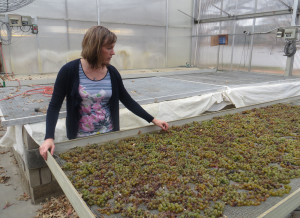
Katie Cook drying grapes for Passito at the University of Minnesota
Temperature control is very important to winemaking in general. Even when I worked at Domaine Zind-Humbrecht in Germany where they were about as natural as a winery can be, they still used temperature control. Temperature control is not manipulating wine; it’s almost a necessity.
But a lot wineries in the Midwest don’t have refrigeration and temperature controls. Jacketed tanks and glycol chilling are expensive. What if a winery does not have the money for temperature control yet?
Any winery with tanks bigger than 50 gallons, needs to start thinking about temperature control. Dry ice can be used directly in the wine to cool down the fermentation – add it directly to the tank. A dry ice maker can be purchased for a few hundred dollars and can be on hand if the fermentation temperature of a tank starts to creep too high. This is the minimum that a winery could have on hand in case they are dealing with hot fermentations. Especially in smaller tanks, a few buckets of dry ice can cool it down considerably.
What kind of temperature control system should a smaller commercial winery be considering?
I think a glycol chiller is the minimum that a winery should invest in. It’s as important to the operation of a commercial winery as pumps and hoses. A small unit, in addition to a couple of cooling plates and hoses, costs under $3,000 and works well for controlling the fermentation temperature in a small winery. (see: http://morewinepro.com/view_product/19740/ for an example.) However, for cold stabilization, or if you were trying to cool many fermentations at once, a winery should consider investing in a better system.
I didn’t know until recently that you did lab testing for wineries?
Yes, we’ve done testing for a while. The fee depends on the test, but it’s usually around $25 which includes pH, TA, Alcohol, ML (malolactic acid) and residual sugar. Checking for ML is important to see if you’re at risk for secondary fermenting in the bottle. We use an enzyme test for ML. It’s more complicated than paper chromatography, but it’s more accurate.
Does a winery have to be located in Minnesota to use the lab testing service?
No, we have tested wine from all over the U.S. We even tested a wine from Lebanon.
We hear about other countries that want to grow University of Minnesota grapes. Can you comment on the status of any international licensing agreements?
The objective of the University is to see our grapes grown around the world. Some of the apple varieties developed at the University, like Honeycrisp and Sweet Tango, are now global. The university has a whole team that is currently involved with negotiations and I can tell you that there some exciting developments going on now with international licensing. I’m confident that we will have partners in Europe in the near future.
What has been the results of the university’s research on KDL?
Our KDL research is not for frost protection. Instead we’re studying how KDL effects fruit chemistry which is using more of our soil science and plant nutrition expertise.
We used KDL with Frontenac and Marquette for a couple of months. It was just one grower with a couple of rows. Some people use KDL to increase brix and there’s little doubt that KDL is effective there. For example, we saw brix go from 26 to 28 where KDL was applied.
However, doing a frost protection study is difficult because it’s impossible to predict whether you will get a frost event. Setting up a scientific trial is complicated and you can go years before you ever get any worthwhile data.
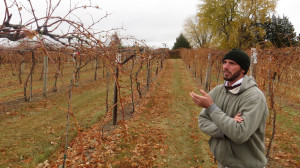
John Thull, Vineyard Manager at the University of Minnesota
There is evidence that KDL will buy you a couple of days of frost protection. But KDL only gets absorbed into the green tissues. For frost protection it might help bud survival. If the vine is hardened off and there are no leaves, it does not do much. However, KDL can help to harden vines in the in winter. A concern I have with KDL is spraying it too close to harvest.
What about the effect of KDL on pH?
It does not seem that KDL effects pH at the level we were applying it. More and more, I am thinking that pH is more a function of grape genetics.
You have the rare ability to go from micro issues to macro issues, so let’s shift gears and talk about the Midwest wine industry. Regional wine is hard to find in many big city restaurants, including Minneapolis. What’s going to motivate restaurants to carry Midwestern wines?
The big challenge is to overcome wine snobbery. I have more respect for open-minded people. Lately, I get the impression that some of the Master of Wine designation holders are opening up to new varieties of wine and small appellations. After all, who wants to drink the same old Cabernet all the time? Brad Beam from Illinois got some Illinois wine on the Today Show last year, and the Master of Wine on the Show was very impressed with Marquette.
How does the Midwest develop an identity for its wines?
On many wine trails in the Midwest you might have 7 or 8 wineries and they each have 10 to 20 different types of wines. That is not how you build an identity. Somehow, wineries across the region need to come together and say, “This is what we stand for.”
What you’re talking about is easier said than done. We have a lot of viewpoints in the Midwest. How do you bring all these opinions about wine together?
When you’re talking about smaller AVAs in the U.S., one of the problems is that there’s a lot of attention to local details like climate and soil. For example, an AVA might stress a unique attribute of that area, like glacial till.
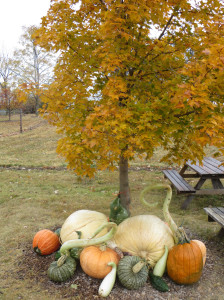
The University of Minnesota also breeds pumpkins and squash which are displayed in the vineyard.
Environmental considerations that make an area unique are important, but it’s how humans interact with this environment that determines what kind of wines will be made in that area. Humans decide what to plant, how to cultivate it, and what style of wine they will make.
In all established wine regions in the world, there was some sort of evolution towards a regional identity. I think this is slowly happening in the Midwest. It will take some time, but I think as soon as individual wineries, as well as groups of wineries in the same region, start taking an honest look at what they do really well, and focus on those products, we will start to see these regional trends become more defined.
In the Midwest, a lot of people like labrusca wines yet I don’t think any wine region wants to call themselves the “Concord Capital.”
I don’t know, I’m seeing Edelweiss turning into a regional specialty in Iowa. I don’t see anything wrong with a region specializing in labrusca-based cultivars. Before Prohibition, much of the Midwest was planted in labrusca-type grapes.
There is now a whole science on how people develop a liking for certain foods and beverages. Once someone has the notion of what a wine is “supposed” to taste like, it is hard to convince them otherwise. Many Midwesterners who visit local wineries have an open mind and aren’t turned-off by the foxy aromas of these grapes. For many of them, the wine just tastes like grapes. Who knows how regional preferences would have evolved if Prohibition never happened?
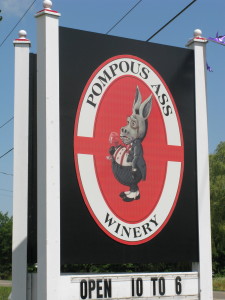
Some Finger Lakes wineries appeal to casual wine drinkers
I think the fear in calling a region the “Concord Capital” is that they may turn-away consumers looking for more traditional, European-style wines. The Finger Lakes is an example of a wine area that’s developed a more complex regional personality. We all know there’s a lot of Concord produced in New York, but Concord wine does not define the Finger Lakes. In New York, some the best Rieslings anywhere are next door to wineries that feature labrusca wines. Although the Finger Lakes has Riesling as its specialty, many wineries there admit that Concord wines are paying the bills.
As we’ve discussed, there is no such thing as “Midwestern wine.” Do you think the lack of a strong regional identity is the reason that we have so much variation in the styles of wine being produced?
I would say the nation as a whole was founded on the idea of individuality, and it’s part of what has led to the success of our country. It’s this pioneering spirit that spurred the Midwest wine industry.
However, individual wineries are beginning to understand that what their neighbor up the road does will have an effect on the consumers that walk through their own door. At the university, we are trying to develop grapes that make wines with more of a vinifera profile that every-day wine drinkers will still be comfortable with.
It may be easier for a wine drinker who already likes Pinot Noir, for example, to embrace Marquette over Norton. That’s not to say that all consumers will prefer Marquette wines over other locally-produced wines. It’s a complicated issue where marketing and consumer preference all play a role.
Katie Cook is the Enology Project Leader in the Department of Horticultural Science at the University of Minnesota. Her blog is at : http://enology.umn.edu/


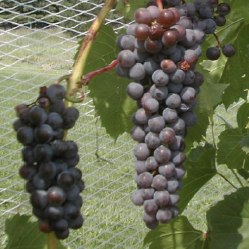
Nice transcript. It’s always interesting to know the background facts about the food and the beverages you serve at your restaurants!
Great interview with wonderful insights. Thanks for posting.